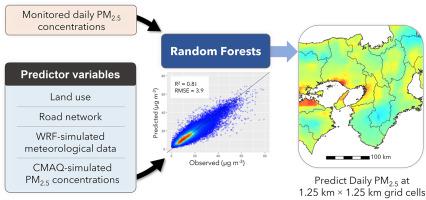Atmospheric Environment ( IF 4.2 ) Pub Date : 2021-07-13 , DOI: 10.1016/j.atmosenv.2021.118620 Tin Thongthammachart 1 , Shin Araki 1 , Hikari Shimadera 1 , Shinnosuke Eto 1 , Tomohito Matsuo 1 , Akira Kondo 1

|
Accurate spatial and temporal prediction of PM2.5 ambient concentration is crucial to appropriate exposure assessment. We develop a spatiotemporal land use regression model by integrating a random forests (RF) technique and the Community Multiscale Air Quality (CMAQ) modeling system to accurately estimate daily PM2.5 levels in the Kansai region of Japan, which is affected by long-range transport in the Asian continent and by local pollution. The most important advantage of RF is that it captures nonlinearity among the target air pollutants and the predictor variables including land-use variables, meteorological variables, and CMAQ-estimated PM2.5 concentration. We compare the predicting performances of the land use random forests (LURF) models with and without CMAQ variables to determine their effectiveness. A cross-validation (CV) technique that calculates the coefficient of determination (R2) and root mean square error (RMSE) is performed to evaluate their prediction performances through spatial and temporal CVs. The performance of the with-CMAQ LURF model was superior to that of the without-CMAQ LURF model. Moreover, we evaluated the PM2.5 prediction performances of the with-CMAQ LURF and the with-CMAQ land use linear regression (LULR) models via CV to determine the efficiency of the non-linear model. Accordingly, the with-CMAQ LURF model is preferable for PM2.5 estimation compared to that of the with-CMAQ LULR model. In addition, the with-CMAQ LURF model exhibits higher PM2.5 predictability than the CMAQ model, as indicated by the higher model-R2 and lower model-RMSE values. Our findings demonstrate that the CMAQ-simulated PM2.5 level integrated into the LURF is advantageous in accurately estimating PM2.5 concentration, which is influenced by long-range transport and local pollution.
中文翻译:

一种结合随机森林和 WRF/CMAQ 模型的集成模型,用于日本关西地区的高精度时空 PM 2.5预测
PM 2.5环境浓度的准确空间和时间预测对于适当的暴露评估至关重要。我们通过集成随机森林 (RF) 技术和社区多尺度空气质量 (CMAQ) 建模系统开发了一个时空土地利用回归模型,以准确估计受远程运输影响的日本关西地区的每日 PM 2.5水平在亚洲大陆和当地污染。RF 最重要的优点是它捕捉目标空气污染物和预测变量之间的非线性,包括土地利用变量、气象变量和 CMAQ 估计的 PM 2.5专注。我们比较了有和没有 CMAQ 变量的土地利用随机森林 (LURF) 模型的预测性能,以确定它们的有效性。执行计算确定系数 (R 2 ) 和均方根误差 (RMSE)的交叉验证 (CV) 技术,以通过空间和时间 CV 评估其预测性能。有 CMAQ LURF 模型的性能优于没有 CMAQ LURF 模型的性能。此外,我们通过 CV评估了with-CMAQ LURF 和 with-CMAQ 土地利用线性回归 (LULR) 模型的 PM 2.5预测性能,以确定非线性模型的效率。因此,with-CMAQ LURF 模型更适用于 PM 2.5与 with-CMAQ LULR 模型的估计相比。此外,与 CMAQ 模型相比,with-CMAQ LURF 模型表现出更高的 PM 2.5可预测性,如较高的模型 R 2和较低的模型 RMSE 值所示。我们的研究结果表明,集成到 LURF中的 CMAQ 模拟 PM 2.5水平有利于准确估计受远程传输和局部污染影响的PM 2.5浓度。











































 京公网安备 11010802027423号
京公网安备 11010802027423号